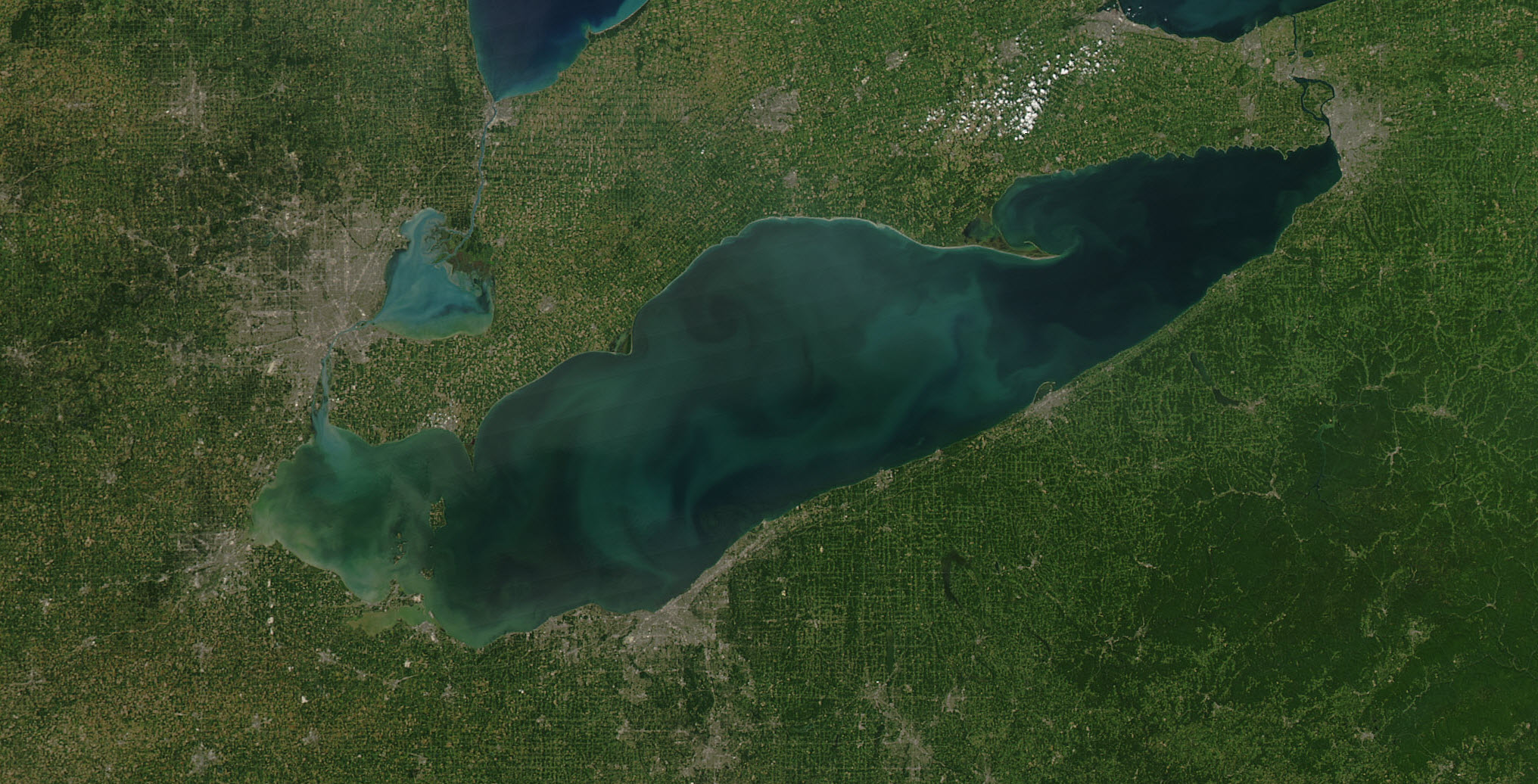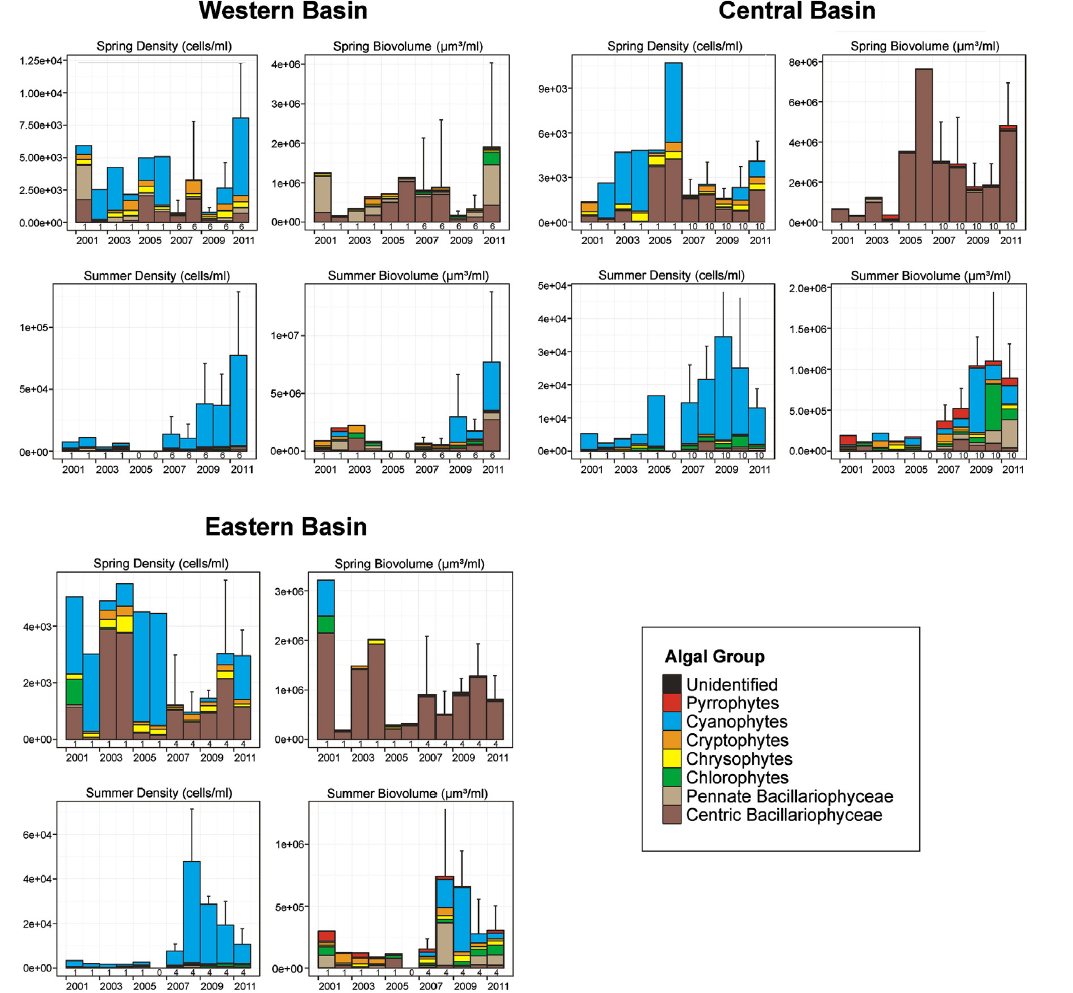Research Summary: Lake Erie’s Ecological History as Recorded by Phytoplankton
0
Lake Erie, August 2010. The pale blue and green swirls near the coasts are likely algae or phytoplankton blooms. (Credit: NASA)
Lake Erie’s water quality has fluctuated since European settlement due to cultural eutrophication and the effects of invasive species. Our attempts to understand the cause-and-effect linkages between observed ecosystem changes and various stressors are evolving. Non-indigenous species, pollutants, land-use and climate change that can alter a lake’s physical and chemical environment can manifest rapid changes in community composition and abundance of phytoplankton. As such, for many decades researchers have used phytoplankton data from Lake Erie to track environmental changes. We provide a chronological account of previous and ongoing assessments of pelagic algae to summarize past and present environmental conditions of Lake Erie. This review necessarily focuses on diatom-based assessments as their preserved remains in sediments have been used to hind-cast human-induced impacts and recovery. Because of their uniqueness, this review summarizes where possible the long-term trends according to the western, central and eastern lake basins. Overall, this historical assessment summarizes a period of significant eutrophication throughout most of the 20th century, followed by water quality improvement due to nutrient reductions and establishment of filter-feeding dreissenids. Recent data suggest new issues associated with blooms of diatoms and blue-green algae. The challenges facing Lake Erie underline the need for continued monitoring and evaluation of historical records that will help us distinguish natural from anthropogenic changes, and to reveal the causes and extent of environmental insults in order to make management decisions.

Historical summary of major events, environmental conditions and determinants that affected algal productivity, abundance and species composition in Lake Erie. (Credit: Lisa Allinger and Euan Reavie)
Phytoplankton-based studies, particularly those using diatoms, have revealed major anthropogenic changes in Lake Erie’s environmental quality. Although researchers have presented evidence of cultural eutrophication in the lake’s open waters since the mid-19th century, the Lake Erie flora has always included species that are tolerant of eutrophic conditions, inferring a naturally productive condition. Phosphorus controls reduced concentrations in open waters by the mid-1980s and by the early 1990s water quality conditions improved primary productivity towards mainly mesotrophic status (e.g., fewer eutrophic phytoplankton). Since then, drastic alterations in the Lake Erie’s ecosystems from the effects of invasive species establishment and possibly climate change are compounded with the reoccurrence of increasing sediment and nutrient loading, particularly in the western basin. The increasing dominance of quagga mussels intensifies these impacts by trapping phosphorus runoff and in-lake phosphorus nearshore, causing algal blooms and changing pelagic lake productivity. Algal blooms, particularly diatoms in the spring and blue-green algae in the summer, are now occurring annually, and the green algae Cladophora dominates the eastern basin shorelines. Based on recent phytoplankton collections, summer blue-green algal abundance has increased possibly due to changing nutrient inputs and dynamics, and dreissenid effects. The dominant spring taxa in Lake Erie by biovolume are centric diatoms, mostly A. islandica, which may be driving winter productivity, seeding subsequent spring blooms, influencing summer central basin hypoxia and facilitating summer species with lower silica requirements.

Lake Erie spring and summer pelagic phytoplankton densities (cells/ml) and biovolumes (μm3/ml) from 2001–2011. The numbers along the x axis in the histograms above the years between 2001 and 2011 indicate total locations for which data are available. Error bars are based on the standard deviation of sample totals. Abundance illustrated during 2001–2005 is based on one available sample from within each basin and may not be indicative of actual overall basin conditions for that period. (Credit: Lisa Allinger and Euan Reavie)
Lake Erie is well known for its cultural eutrophication history, but ecological shifts resulting from climate change and aquatic invasive species are also important considerations in protecting the water quality and biodiversity of the lake. At this time a biodiversity strategy has been recommended to include long-term strategies to restore and protect the chemical, physical and biological integrity of the Lake Erie ecosystem (U.S. EPA, 2012). The combined effects of nutrient mitigation and invasive species expansion demonstrate the challenges facing Lake Erie and underline the need to continue improving our understanding of the mechanisms driving them. Advances in monitoring and paleolimnological technologies (e.g., Pienitz et al., 2009) can provide crucial long-term interpretations in order to inform management. We have therefore initiated a new paleolimnological study, supported by EPA-GLNPO, to reconstruct the long-term environmental history of the lake via investigation of sediment cores collected in 2011. This new research to revisit previously-described trends and fill gaps in knowledge about lake conditions will provide crucial long-term interpretations in light of more recent changes and observations associated with Lake Erie’s pelagic primary producers.
Acknowledgements
M. Agbeti supported assessments of the recent GLNPO phytoplankton samples and R. Barbiero provided quality assessment for the data. We thank J. Wolin and an anonymous reviewer for helpful input on this manuscript. This research was partly supported by a grant to E. Reavie from the U.S. Environmental Protection Agency under Cooperative Agreements GL-00E23101. This document has not been subjected to the Agency’s required peer and policy review and therefore does not necessarily reflect the view of the Agency, and no official endorsement should be inferred. This is contribution number 546 of the Center for Water and the Environment, Natural Resources Research Institute, University of Minnesota Duluth.
Full study and references published September 2013 in the Journal of Great Lakes Research (Volume 39, Issue 3, Pages 365-382).
Selected References
- Allen, J.A., 1915. Shells of Put-in-Bay, Lake. Nautilus 29, 18–20.
- Arnott, D.L., Vanni, M.J., 1996. Nitrogen and phosphorus recycling by the zebra mussel (Dreissena polymorpha) in the western basin of Lake Erie. Can. J. Fish. Aquat. Sci. 53, 646–659.
- Auer, M.T., Tomlinson, L.M., Higgins, S.N., Malkin, S.Y., Howell, E.T., Bootsma, H.A., 2010. Great Lakes Cladophora in the 21st century: same algae—different ecosystem. J. Great Lakes Res. 36, 248–255.
- Baker, D.B., 2007. Phosphorus loading to Lake Erie: a brief overview, including recent changes in dissolved reactive phosphorus from tributaries. www.epa.ohio.gov/portals/35/lakeerie/ptaskforce/BakerBullets.pdf (Accessed March 1, 2013).
- Barbiero, R.P., Tuchman, M.L., 2001. Results from the US EPA’s biological open water surveillance program of the Laurentian Great Lakes: I. Introduction and phytoplankton results. J. Great Lakes Res. 27, 134–154.
- Barbiero, R.P., Rockwell, D.C., Warren, G.J., Tuchman, M.L., 2006. Changes in spring phytoplankton communities and nutrient dynamics in the eastern basin of Lake Erie since the invasion of Dreissena spp. Can. J. Fish. Aquat. Sci. 63, 1549–1563.
- Barbiero, R.P., Schmude, K., Lesht, B.M., Riseng, C.M., Warren, G.J., Tuchman, M.L., 2011. Trends in Diporeia populations across the Laurentian Great Lakes, 1997–2009. J. Great Lakes Res. 37, 9–17.
- Beeton, A.M., 1961. Environmental changes in Lake Erie. Trans. Am. Fish. Soc. 90, 153–159.
- Beeton, A.M., 1965. Eutrophication of the St. Lawrence Great Lakes. Limnol. Oceanogr. 10, 240–254.
- Beeton, A.M., 1966. Indices of Great Lakes eutrophication. Proc. Ninth Conf. on Great Lakes Res. Great Lakes Res. Div. Publ, 15. Univ. Michigan, pp. 1–8.













